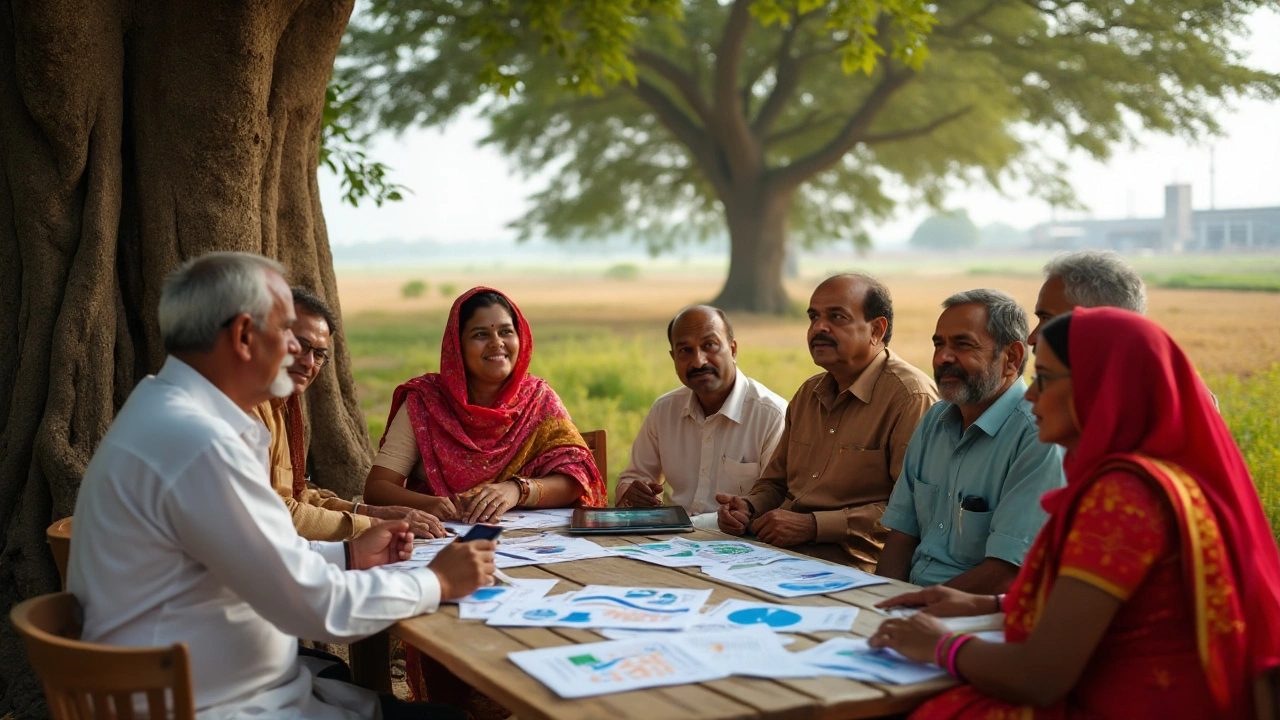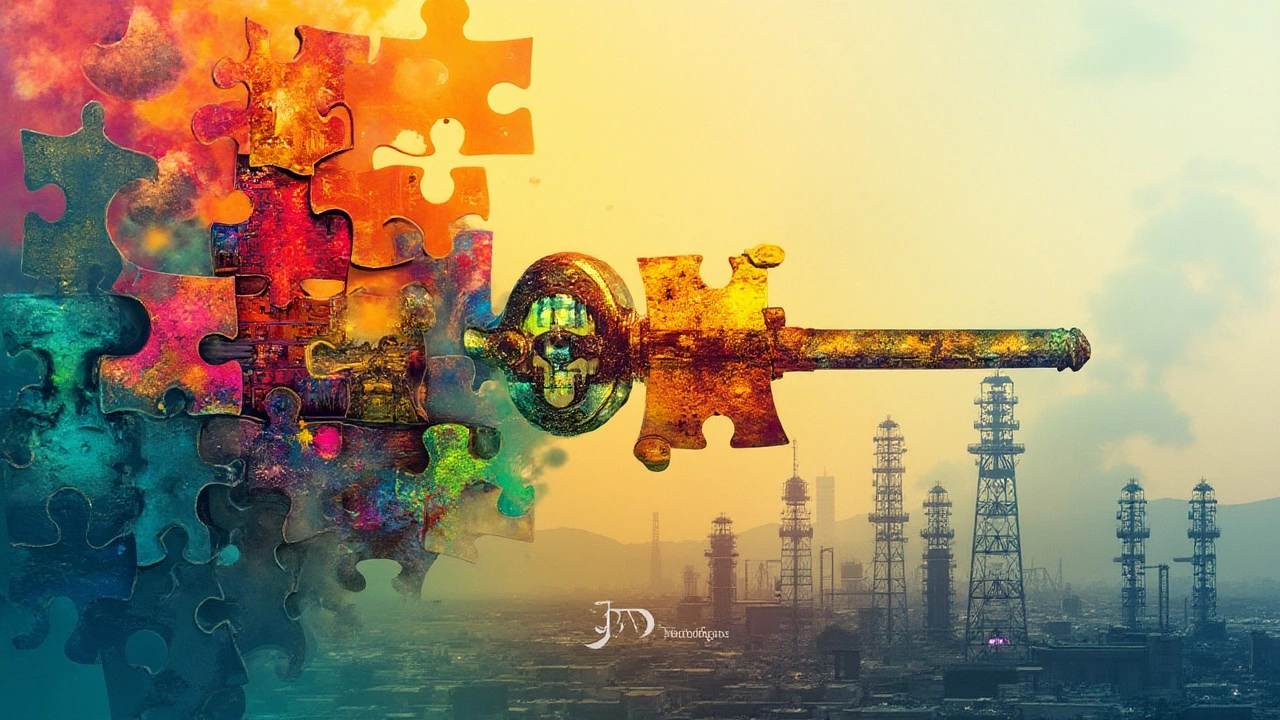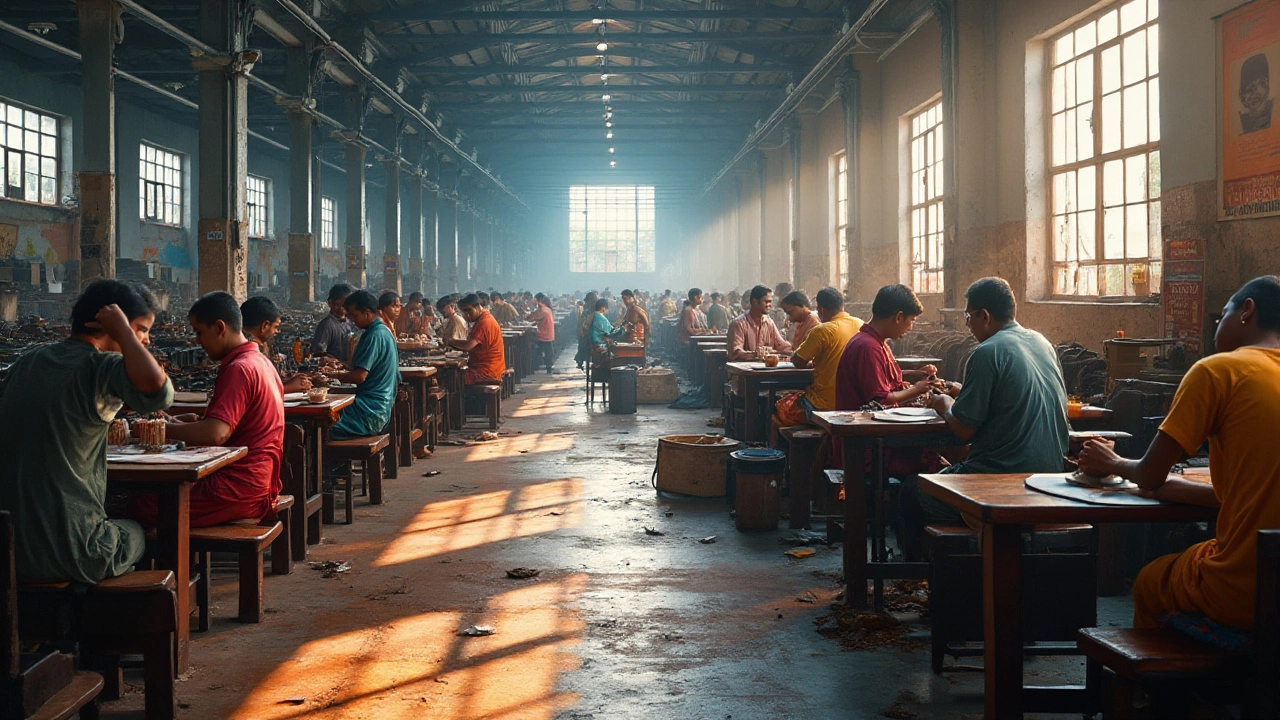The world of manufacturing is a bustling ecosystem filled with opportunities and hurdles alike. It stands as a backbone of economic growth but is not without its flaws. Many manufacturers face an array of challenges that can slow progress or, in some cases, bring operations to a grinding halt.
Government schemes step in with the hope of providing support and solutions, but can often find themselves tangled in bureaucracy and red tape. These initiatives are created with good intentions; however, translating policies into practice is where difficulties often arise.
Examining the current landscape, one finds that the symbiosis between manufacturing and government efforts is crucial, yet delicate. This dance of policy and practice holds the key to unlocking potential and paving the way for future advancements. Through understanding these complexities, industries can strive for innovation and improvement.
- Understanding Manufacturing Challenges
- Role of Government Schemes
- Impact on Economic Growth
- Successful Case Studies
- Future Prospects and Recommendations
Understanding Manufacturing Challenges
Manufacturing is a dynamic sector that is essential for economic development, innovation, and employment generation. Despite its significance, it grapples with numerous challenges that stem from both internal inefficiencies and external pressures. Among these, rising costs in raw materials, lack of technological advancement, and workforce skills mismatch stand out as persistent issues that manufacturers face globally. Another pressing challenge is the ever-increasing competition in the globalized market, which forces manufacturers to consistently innovate and improve cost-efficiency to remain viable.
Regulations and compliance requirements add an additional layer of complexity. Industries must often navigate a labyrinth of environmental, safety, and quality standards, which, while necessary for sustainable operations, can be difficult to comply with due to resource constraints. Access to capital is another hurdle many manufacturing enterprises struggle with, especially small and medium enterprises (SMEs), which constitute a significant portion of the sector. Limited access to funding impacts their capacity to expand, adopt new technologies, or improve production processes.
Supply chain disruptions, as seen in recent years, underscore the vulnerability of manufacturing systems to external shocks. Events like geopolitical tensions, pandemics, or natural disasters can halt operations and cause financial strains. A report from the World Economic Forum noted, "In today's interconnected world, supply chain resiliency is not just a necessity, it's a strategic advantage."
The ability to anticipate and mitigate these disruptions will define the next generation of successful manufacturers.
On a strategic level, the adaptation to digital transformation and Industry 4.0 technologies presents a dual challenge and opportunity. While adopting digital tools like IoT, robotics, and AI can enhance efficiency and product quality, these require substantial investment and a skilled workforce, which many firms are still lacking. Additionally, maintaining cybersecurity in an increasingly digital world is an ongoing concern as cyber threats grow in sophistication and frequency.
Energy consumption and sustainability are increasingly crucial concerns for manufacturers, with many industry leaders advocating for a shift toward greener practices. This is not only a matter of corporate social responsibility but also a strategic necessity in the face of global climate change policies and consumer demand shifts towards sustainable products. Companies that cannot pivot towards sustainable practices risk being left behind. These challenges, while daunting, also open avenues for innovation and collaboration, pushing the manufacturing sector toward future-oriented solutions and sustainable growth.
Role of Government Schemes
Governments around the world recognize the strategic importance of manufacturing in fostering economic stability and growth. To combat the myriad challenges facing this sector, various government schemes are put in place, each poised to address specific issues like funding, innovation, and workforce skills enhancement. One such prominent initiative is the 'Make in India' campaign, which aims to transform the country into a global manufacturing hub. This program encourages both domestic and foreign investors to take part in the creation of a robust manufacturing ecosystem.
Among the primary focuses of these schemes is providing access to financial resources. In many cases, smaller manufacturing units struggle with liquidity, affecting their ability to scale operations or invest in new technologies. To address such constraints, the government introduces financial subsidies, low-interest loans, or tax incentives. These financial aids are structured to reduce the burden of initial investments, allowing businesses to channel resources into more productive areas. There's evidence showing that financially backed initiatives lead to a measurable increase in production capacity and employment rates across sectors.
Innovation is another critical area where government schemes have made substantial impacts. The introduction of technological upgrades and research grants helps in bridging the gap between current practices and cutting-edge advancements. Initiatives like technology parks or dedicated zones for high-tech industries aim to centralize resources, creating an environment that nurtures innovation. Through strategic partnerships with universities and research institutions, these programs foster a culture of continuous improvement, crucial for staying competitive in a rapidly evolving global market.
"Effective industrial policy can lift millions out of poverty while creating a resilient and diverse economy," states an economist from the United Nations Industrial Development Organization. This underscores the transformative potential of well-implemented government schemes.
Moreover, the emphasis on skill development cannot be ignored. The manufacturing sector's growth is directly proportional to the availability of a skilled workforce. By providing training programs, apprenticeships, and educational incentives, government schemes help in upskilling the labor force, ensuring a steady supply of qualified personnel. This approach not only enhances productivity but also opens up numerous career opportunities for the youth, addressing unemployment.
The strategic use of government schemes in manufacturing showcases their pivotal role in addressing sector-specific challenges and driving economic progress. However, transparency and efficient execution remain critical to the success of these initiatives. Continued evaluation and adaptation of these policies, informed by empirical data and industry feedback, will be essential in realizing their full potential and sustaining growth in the long run. Governments must remain vigilant, ensuring that these schemes evolve alongside technological advancements and market demands, thereby securing a vibrant economic future.

Impact on Economic Growth
Manufacturing has always been a significant pillar in shaping the economic growth of nations across the globe. It acts as a catalyst that drives various sectors, creating a ripple effect that can stimulate or hinder progress. When manufacturing thrives, it tends to boost employment rates, foster innovation, and increase the GDP substantially. However, the relationship between manufacturing outputs and economic health is intricate, influenced by numerous factors including technology, government policies, and global trade dynamics.
The role of manufacturing extends beyond simple production. It involves a complex chain of activities that include procurement, process engineering, and logistics, each playing a crucial part in determining economic outcomes. On average, manufacturing sectors contribute significantly to exports, making them essential for a healthy balance of trade. In many nations, manufacturing is responsible for a substantial percentage of export revenues, providing a financial buffer that protects against international disturbances. However, the environment is often volatile, with global demand fluctuations and technological disruptions constantly influencing the playing field.
Effective government policies such as tax incentives, research and development grants, and direct subsidies are tools that can nurture manufacturing sectors. These government schemes aim to alleviate some of the chronic issues plaguing manufacturers, from outdated infrastructure to regulatory red tape. Yet, despite these schemes, challenges such as labor shortages, skill gaps, and environmental regulations can create bottlenecks that stall growth execution. There has been a consistent call for better policy alignment with industrial needs, suggesting that more targeted interventions could yield better returns and economic resilience.
Interestingly, the IMF highlights that nations with robust manufacturing sectors tend to have more stable economies.
"Manufacturing is a critical engine of economic growth... countries with advanced manufacturing sectors are more likely to weather global economic storms," a report from the International Monetary Fund suggests.Yet, the competitive global landscape means that staying ahead requires continuous improvement and adaptation. Innovations in digital manufacturing, AI, and nanotechnology are beginning to redefine traditional models, offering new pathways to enhance efficiency and reduce costs.
Collaboration between government bodies and manufacturing industries remains crucial. Initiatives that focus on upskilling the workforce, integrating advanced technologies, and promoting sustainable practices not only bolster economic growth but also ensure long-term viability. Leading by example, some countries have successfully integrated sustainable manufacturing with economic policy to create thriving industrial frameworks. For instance, Germany's "Industry 4.0" initiative illustrates how digital transformation across the manufacturing sector can lead to greater efficiency and competitiveness in a global market.
| Country | Manufacturing Output Contribution to GDP (%) |
|---|---|
| China | 27.7 |
| Germany | 23.5 |
| USA | 11.6 |
Successful Case Studies
Exploring the landscape of manufacturing challenges, it's heartening to find various instances where government schemes have successfully propelled industries to new heights. These case studies serve as beacons of hope and models for replicative success. Take, for instance, India's "Make in India" initiative, launched in 2014. This effort aimed at transforming the country into a global manufacturing hub by fostering job creation and skill enhancement. This movement was crucial in repositioning India on the world stage, encouraging domestic and foreign investment through favorable policy reforms and easing the regulatory framework.
The scheme focused on 25 sectors, ranging from automobiles to biotechnology, making it one of the most ambitious manufacturing initiatives in recent times. According to the Department for Promotion of Industry and Internal Trade (DPIIT), foreign direct investment (FDI) inflows increased by 18% to USD 49.97 billion during the fiscal year 2019-2020, illustrating the initiative's success in attracting international capital. The government offered incentives, streamlined business processes, and emphasized the importance of indigenous production to reduce dependence on imports. This case study demonstrates the critical role of strategic public policy in tackling industrial policy hurdles.
Japan presents another compelling narrative. The post-war economic miracle of Japan highlights how government intervention can stimulate the manufacturing sector. Japan's Ministry of International Trade and Industry (MITI) played a pivotal role in fostering collaboration between the state and private enterprises. MITI encouraged industries to adopt new technologies and emphasized innovation, which underscored Japan's economic rebuild. The strategic focus on technology and quality improvement ushered Japan into becoming a leader in the automotive and electronics industries by the 1980s.
"Without crises there are no challenges, without challenges there is no progress. As economies evolve, so must the policies that guide them," said Keiretsu, a notable industrial analyst, reflecting the ethos that drove Japan's resurgence.
Another interesting exemplar comes from Germany with its Industrie 4.0 initiative. This approach integrates modern manufacturing with smart technology — a perfect blend of industrial might and digital prowess. It strengthens Germany's manufacturing prowess by leveraging the Internet of Things (IoT), artificial intelligence (AI), and advanced data analytics to optimize production processes, reduce wastage, and enhance productivity. An essential element of this initiative was the partnership between academia, the government, and private enterprises, ensuring a collaborative ecosystem that fosters innovation and technological advancement.
Listing emerging markets, Vietnam has displayed a remarkable turnaround in its economic growth through strategic government policies conducive to industrial expansion. By signing over two dozen free trade agreements and creating several industrial zones, Vietnam has surged as a hub for electronics manufacturing. It is forecasted that Vietnam will become one of the world's top 20 economies by 2050. According to the General Statistics Office of Vietnam, the industrial sector contributed approximately 34.5% of the GDP in 2020. This is a testament to how tailored government schemes can turn a nation's manufacturing sector into a significant engine of economic development.

Future Prospects and Recommendations
The future of manufacturing is both exciting and daunting, presenting an array of prospects and challenges that need to be carefully navigated. The journey forward will be shaped largely by how effectively governments can implement and fine-tune their government schemes to truly support industrial growth. One promising avenue is the integration of advanced technologies such as AI and IoT into manufacturing processes, which can significantly enhance efficiency and production capabilities. However, this requires not only financial investment but also a skilled workforce capable of managing these technologies.
Considering these dynamics, it is crucial that educational institutions and vocational training centers are aligned with industry needs. Developing curriculums that incorporate practical, technology-oriented skills will foster a generation equipped to handle and thrive in modern manufacturing environments. Governments can play a pivotal role by incentivizing institutions that produce innovation-ready graduates. The private sector should also engage in partnerships with educational bodies to facilitate internships and hands-on training opportunities, creating a seamless pipeline from education to employment.
Industry leaders must also focus on sustainability and environmental responsibility. As global awareness regarding climate change and resource depletion escalates, manufacturing practices will be under intensified scrutiny. Employing environmentally friendly procedures not only addresses regulatory compliance but can also be a competitive advantage. Reducing waste, optimizing resource use, and lowering emissions are just some of the areas where manufacturers can make a significant impact. Incentivizing green initiatives through tax breaks and subsidies is a government strategy that could encourage more industries to adopt sustainable practices.
"The only way forward, if we are going to improve the quality of the environment, is to get everybody involved." - Richard Rogers
A particular focus on small and medium-sized enterprises (SMEs) is essential, as they often lack the resources to keep up with technological and regulatory changes compared to larger corporations. There are significant hurdles, such as access to capital and markets, that SMEs frequently confront. Tailoring economic growth strategies to address these challenges can catalyze broader industrial sector gains. Government schemes aimed at providing SMEs with better access to financing, technology, and market information are crucial.
Countries excelling in manufacturing often have a strong strategic vision that aligns state efforts with industry capabilities. A blueprint that clearly defines an industry’s future trajectory and supports innovation can vastly improve outcomes. Collaborative policymaking with stakeholders across the industry, academia, and government bodies ensures that initiatives resonate with actual market needs rather than theoretical expectations. The shift towards a cohesive and inclusive approach could create a nurturing environment for manufacturing to flourish, ultimately benefiting the global economy.
